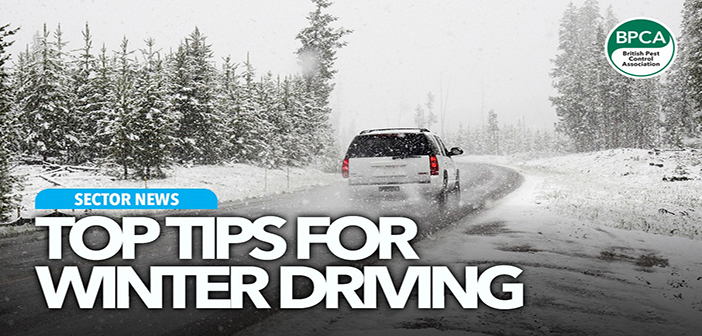Driving in winter conditions can be dangerous, so BPCA have put together some tips for pest controllers to stay safe on the roads.
Pest controllers spend a lot of time driving, going from job to job, so it’s important to know how to keep yourself and others safe on the roads, and your vehicle in good nick during cold snaps.
Different areas of the UK may experience different extremes of weather, such as snow in the highlands of Scotland or windy conditions along coastal areas.
And the rest of us get a milder but still dangerous set of conditions to deal with.
How to stay safe
Staying safe is mainly about common sense, but it’s also about caring about your safety and others’.
Reduce your speed
Running late for the next appointment? Well, better late than never. You won’t know where black ice is and exposed areas such as bridges and open roads can ice up quickly.
Also pay particular attention to more sheltered areas such as under trees, which can take longer to thaw if subject to ice. Rural areas can get very icy, and are often the last roads to get treated with grit.
Check your lights
A lot of modern cars automatically switch dipped lights on at night or in poor visibility. However not all cars are that smart and in fog, they don’t always come on – this can leave to driving in bad visibility with no lights on. If you’re unsure, manually switch your lights on before you start or when you are in fog.
And remember – don’t use your high beam lights in the fog! It’s tempting to use them, but high beam lights will make your vision worse in fog, as the light will hit the water droplets/moisture in the air and reflect back at you.
Check your brake lights work periodically – it’s essential that other drivers are alerted when you start braking in poor conditions, as it gives them more time to react. AA recommends testing these once a week.
Increase your distance
It’s hard to judge the speed of other vehicles in fog/freezing fog and decreased visibility means longer braking times. Exercise caution and be prepared for mishaps, such as vehicles pulling out in front of you at junctions. They could have failed to judge your distance properly.
Also be aware of drivers tailgating in fog. Some people feel a need to be closer to other drivers where vision is limited, often using lights from other cars as a guide. Chances are they are not being combative – just totally unaware of the risks and what they are doing.
Don’t respond by driving aggressively – just continue to drive to the conditions yourself.
Brake gently
The sooner you begin to slowly brake during poor weather conditions, the better. It gives other drivers ample warning that you are slowing down and you are less likely to skid on ice. It also helps with the previous point – if someone is driving close to you, it gives them time to brake too.
Take care of your vehicle
Make sure it’s well serviced (beyond your yearly MOT), that the lights work, and that the wipers and tyres are all in good condition. You should also keep extra blankets and warm clothes in your car, in case you get stuck for long periods of time.
Do a POWDER check often:
Petrol – Make sure you have enough fuel for your journey and more;
Oil – Check your oil and top up if needed;
Water – Check coolant/antifreeze and also washer fluid;
Damage – If you have any vehicle damage will it be a risk to you or other road users?;
Electrics – Are your electrics working? Lights, and indicators for example; and?
Rubber – Check your tyres for grip, and cuts and bulges to the tyres.


